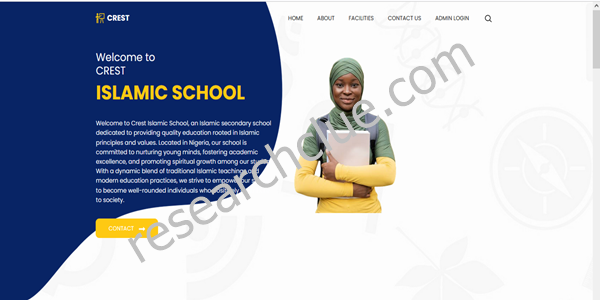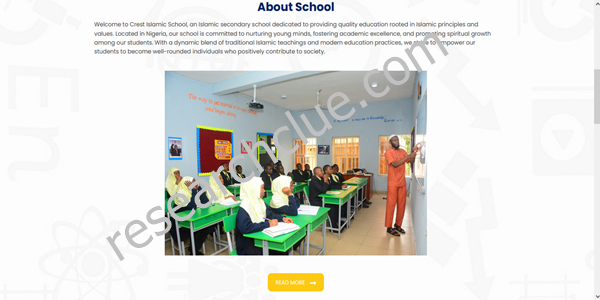ABSTRACT
The paper examines Design and implementation of an Islamic Secondary School web site. Considering the numerous challenges people who need to make inquiries on the services and operations of an Islamic school face, the paper aims at developing a secure and convenient Islamic secondary school website where students, teachers and visitors can access 24/7 to get important information about the Islamic school in real time. Considering technology used in implementing this work, the researcher used HTML, CSS, SQL and PHP. These technologies were considered because of its robust and simplicity in solving complex issues faced by many campuses in Nigeria.
CHAPTER ONE
INTRODUCTION
1.1 Background to the Study
The design and implementation of a website for an Islamic secondary school represents a crucial intersection of technology and education, catering to the specific needs and values of Muslim students and their communities (Al-Azhar Quran Teaching, n.d.; Islamic School Web Design by i4 Solutions, n.d.). In an increasingly digital world, the importance of a well-crafted online presence cannot be overstated, especially for educational institutions seeking to provide accessible and comprehensive information to prospective students, parents, and stakeholders. This introductory discussion aims to delve into the key considerations and principles underlying the development of such a website, drawing upon both technological and cultural dimensions.
Firstly, the design of the website must reflect the ethos and values of Islamic education, embodying principles of inclusivity, morality, and excellence (Mohamed, 2019; Farooqui & Ahmad, 2020). This involves not only aesthetic choices but also content curation and user experience considerations. The website should serve as a virtual extension of the school environment, fostering a sense of belonging and identity among visitors. Moreover, it should offer resources and information that align with Islamic teachings, covering diverse subjects ranging from academic curriculum to religious studies and extracurricular activities.
Secondly, the implementation of the website necessitates careful attention to technical aspects, ensuring functionality, security, and scalability (Khan & Uddin, 2018). Leveraging modern web development frameworks and technologies, developers can create an intuitive and responsive platform that adapts to various devices and user preferences. Accessibility features should be integrated to accommodate users with disabilities, adhering to principles of universal design. Additionally, robust security measures must be in place to safeguard sensitive information and protect against cyber threats, thereby instilling trust and confidence among users.
1.2 Statement of the Problem
The design and implementation of a website for an Islamic secondary school presents a multifaceted challenge that encompasses both technological and cultural considerations. At its core, the primary problem lies in crafting a digital platform that authentically represents the ethos, values, and educational offerings of the Islamic institution while ensuring accessibility, usability, and security. Balancing the need for an aesthetically pleasing interface with the requirement for comprehensive and accurate content delivery poses a significant challenge. Additionally, integrating Islamic teachings and principles into various facets of the website, such as curriculum descriptions, religious resources, and community engagement features, requires thoughtful planning and execution to resonate with the target audience effectively. Moreover, addressing potential technical issues related to website functionality, compatibility across devices, and data security further complicates the task of designing and implementing an Islamic secondary school website that meets the diverse needs of students, parents, staff, and other stakeholders.
1.3 Objectives of the Study
The main objective of the study is to examine Design and implementation of an Islamic Secondary School web site. Specific objectives of the study are:
- To design a well-structured and optimized database management system to store, process and retrieve the information of the Islamic Secondary School in real-time.
- To design and Implement a secure website not prone to internal and external attacks.
- To create a fast query system where visitors, students and teachers can search for information about the school in real-time.
- To proffer solutions to the challenges and enhance already existing systems in place.
SCREEN SHOTS OF THE APPLICATION


1.4 Significance of the Study
The study is important for many reasons. The following are the major stakeholders this paper through its practical and theoretical implications and findings will be of great significance:
Firstly, the paper will benefit major stakeholders and policy makers in the Information Technology sector. The various analysis, findings and discussions outlined in this paper will serve as a guide in enabling major positive changes in the industry and sub-sectors.
Secondly, the paper is also beneficial to the organizations used for the research. Since first hand data was gotten and analysed from the organization, they stand a chance to benefit directly from the findings of the study in respect to their various organizations. These findings will fast track growth and enable productivity in the organisations used as a case study.
Finally, the paper will serve as a guide to other researchers willing to research further into the subject matter. Through the conclusions, limitations and gaps identified in the subject matter, other student and independent researchers can have a well laid foundation to conduct further studies.
1.7 Scope of the Study
The study is delimited to Crest Islamic International School. Findings and recommendations from the study reflects the views and opinions of respondents sampled in the area. It may not reflect the entire picture in the population.
1.8 Limitations of the Study
The major limitations of the research study are time, financial constraints and delays from respondents. The researcher had difficulties combining lectures with field work. Financial constraints in form of getting adequate funds and sponsors to print questionnaires, hold Focus group discussions and logistics was recorded. Finally, respondents were a bit reluctant in filling questionnaires and submitting them on time. This delayed the project work a bit.
1.9 Organization of the Study
The study is made up of five (5) Chapters. Chapter one of the study gives a general introduction to the subject matter, background to the problem as well as a detailed problem statement of the research. This chapter also sets the objectives of the paper in motion detailing out the significance and scope of the paper.
Chapter Two of the paper entails the review of related literature with regards to corporate governance and integrated reporting. This chapter outlines the conceptual reviews, theoretical reviews and empirical reviews of the study.
Chapter three focuses on the methodology and analysis of the existing system. This gives an insight into the analysis of systems in place already, facts finding sources, input analysis, output analysis, process analysis and objectives of the new system to be implemented.
Chapter Four focuses on the Analysis of the New system to be Implemented, the design standard, output specification and design, input specification and design, system flow chart and requirements.
Chapter Five outlines the findings, conclusions and recommendations of the study. Based on objectives set out, the researcher concludes the paper by answering all research questions set out in the study.
1.10 Definition of Terms
- Islamic Secondary School: An educational institution that provides secondary-level education, adhering to Islamic principles, teachings, and values in its curriculum, pedagogy, and school culture. Typically, such schools offer a combination of academic subjects along with Islamic studies and may cater to Muslim students and communities.
- Web Design: The process of conceptualizing, planning, and creating the visual and interactive elements of a website. It involves considerations such as layout, color scheme, typography, and user interface design to ensure an aesthetically pleasing and user-friendly online experience.
- Implementation: The practical realization of the design plan into a functional website. Implementation includes coding, programming, and integrating various technologies and features to bring the design concept to life on the web.
- Islamic Ethics and Values: Principles derived from Islamic teachings and ethics that guide behavior, interactions, and decision-making within the context of the school community. This may encompass virtues such as honesty, integrity, compassion, and respect for diversity.
- Accessibility: The design and implementation of features that ensure equal access to information and services on the website for all users, including those with disabilities. This involves adhering to standards such as the Web Content Accessibility Guidelines (WCAG) to make the website perceivable, operable, and understandable for a diverse audience.
- Content Management System (CMS): A software application or platform that facilitates the creation, editing, organization, and publishing of digital content on the website. CMS allows administrators and users to manage website content without requiring advanced technical skills.
- Cybersecurity: Measures and protocols implemented to protect the website and its users from cyber threats, such as hacking, data breaches, malware, and phishing attacks. This includes implementing security protocols, encryption, firewalls, and regular updates to mitigate vulnerabilities and safeguard sensitive information.
- User Experience (UX): The overall experience and satisfaction of users when interacting with the website, encompassing factors such as ease of navigation, speed, clarity of information, and responsiveness. UX design aims to optimize user interaction and engagement with the website to enhance usability and user satisfaction.
